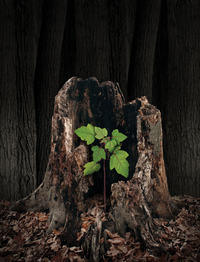A New Beginning
Testers constantly encounter new trends in the experimental branches of Linux distributions. I look at who drives Linux forward and how the future is shaping up.
|

Lightwise, 123RF
Testers constantly encounter new trends in the experimental branches of Linux distributions. I look at who drives Linux forward and how the future is shaping up.
The Linux operating system kernel will celebrate its 25th birthday this coming summer. During its lifetime, a fantastic variety of digital ecosystems have developed around both the kernel and the GNU software suite. In the meantime, developers continue to work carefully and in well-defined increments on the kernel itself. There are no huge leaps forward. Instead, steady improvement done in manageable steps is preferred.
The term "Linux" has taken on various meanings in popular usage. In this article, however, the term refers to the Linux kernel and the surrounding distributions. Here, I will look at the question of who has set the technology and idealogical standards for development in the past, and who will continue to do so in the future.
The development occurring over the past few years reflects the adage that it's not always necessary to reinvent the wheel. Developers are using and extending older technologies in new ways. An example of this is systemd, a tool that has become established in the kernel, using functions like namespaces and Cgroups as its essential components (Figure 1).
[...]
Pages: 7
Some Linux followers see systemd as the best thing since sliced bread – for others, it's the work of the devil. However, it also has the stuff to clear out old trenches and form a unified base for Linux.
Clear Linux is an innovative cloud operating system optimized for the Intel architecture.
BunsenLabs Linux is a community continuation of CrunchBang. Like its predecessor, BunsenLabs is based on the stable version of Debian, in this case, Debian Jessie. It is also appealing thanks to its radically modified Openbox window manager.
Canonical wants to leave the Debian package format behind and give Snappy Personal a new lease on life.
The developers introduced version 2.0 of Kali Linux in mid-August. It is a distribution that specializes in system and network security. This is not limited to cosmetic changes – in fact, Kali actually features many important innovations.
© 2025 Linux New Media USA, LLC – Legal Notice